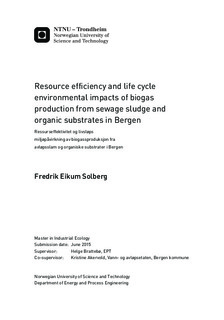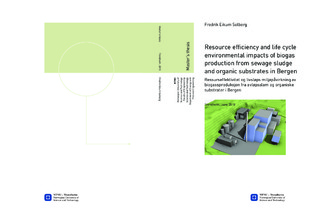| dc.description.abstract | Background, Aims and Scope. This study bases itself on the completion of a biogas plant in Rådalen, Bergen, currently under construction. The reason for the construction of the plant is the mandatory secondary cleaning at the wastewater treatment plants (WWTPs), this demand will increase the amount of sewage sludge from present 4,000 tons to 40,000 tons when completed. The dewatered sewage sludge would normally be transported for further treatment; this predicted increase of sludge is forcing the city to look into new solution for its waste management. Location for the biogas plant is chosen to be next door to the municipal incineration plant that delivers heat to the city and industry, and is a reasonable solution of co-location of waste management. The plant is mainly to utilise sewage sludge from the city s WWTPs, including other organic waste from industries and companies around in Bergen. The aim of this study is to highlight the environmental improvements that might happen with a transfer from today s waste management, to a biogas system, and defines down to one-ton dry matter into the system.
Methods. Through the study, three methods are used; literature study and quantitative methods through material flow analysis (MFA) and life cycle assessment (LCA). The literature study focus mainly on building up the knowledge around the system. Where mainly literature from Norway, Sweden, and books on the system are used. Through MFA, the flow of mass and energy that enter and leaves the processes, that further will give a defined energy efficiency and material rate of recovery of materials and nutrients (RR, NR, and PR). All calculations and definitions where done according to the defined functional unit (FU), one ton dry matter treated organic waste substrate. Calculations were done with predetermined parameters and assumptions based on literature and necessary calculations, and all environmental impacts were calculated through the program SimaPro.
Results and Discussion. Results from the MFA shows for the case chosen a RR at 53.96%, NR at 35.37%, PR at 90%, and with an energy efficiency at 32.23%. Further from the LCA performed reductions are shown in all impact categories looked at, with a total impact at 147.62 kg CO2-equivalents/FU and a total impact reduction at -556.4 kg CO2-equivalents/FU with a total impact from the system at -408.78 kg CO2-equivalents/FU. The Bus substitution represent the replacement of diesel and the largest impact reduction, however as Bergen has several buses running on natural gas, it is more likely that natural gas will be replaced, this would reduce the substitution effect somewhat, even with a 80% reduction of this process the system would still have a total negative impact.
Conclusion. The use of biomethane for replacement of fossil fuels, and bioresidual as replacement of chemical fertiliser is a sound solution for the future, and overall is the best choice for the case of Rådalen Biogas Plant in Bergen. | |

